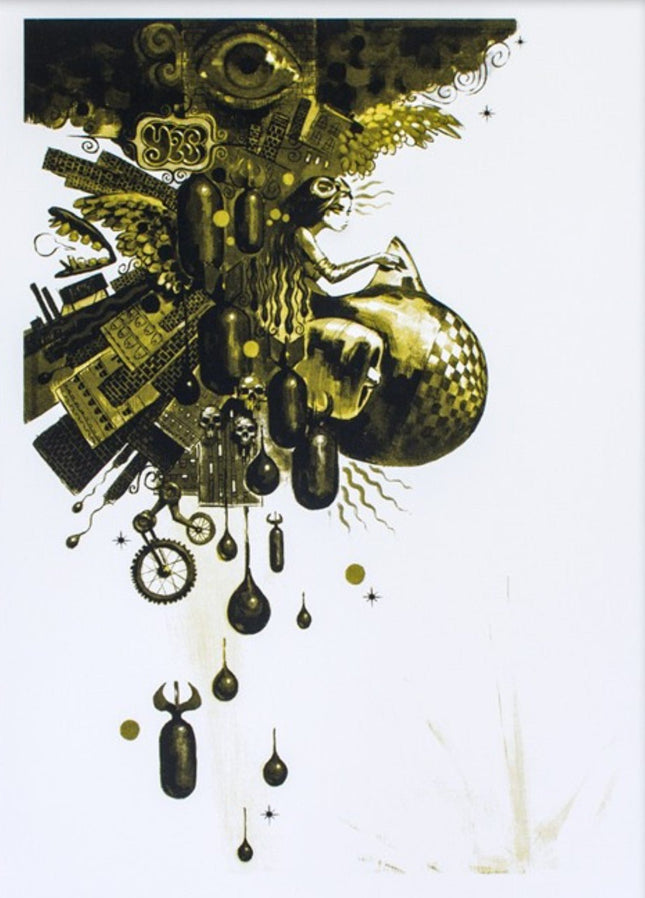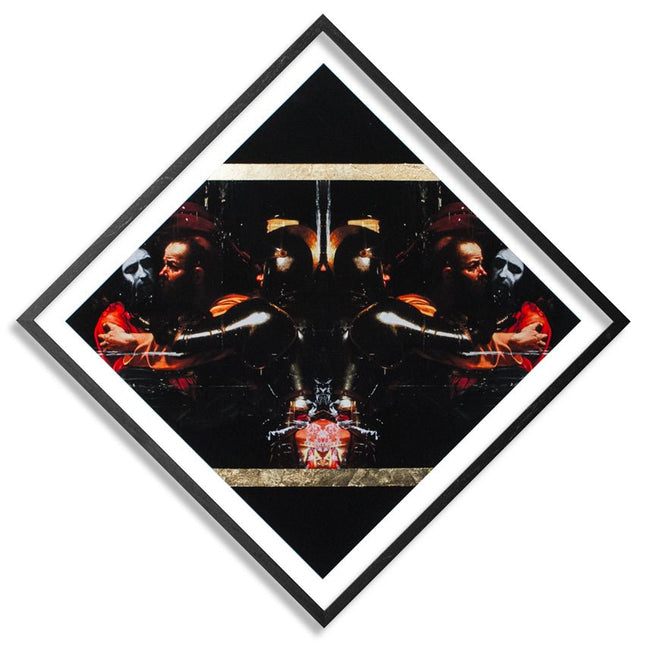
Religion
-

Glenn Barr Muse of the World Ochre Silkscreen Print by Glenn Barr
Muse of the World- Ochre Limited 2-Color Screen Print on 140lbs French Fine Art Paper by Glenn Barr street artist modern pop art. "This image was a popular poster I had released a few years ago. I decided to take it to a more “handcrafted” limited edition print different from offset. Last year I had it transcribed into a 2 color silk screen print and released it with only 25 in the edition, made for my show at Inner State Gallery in Detroit...They went fast. In celebration of the popular image I wanted to do another version. This time changing the color ways from the electric red. 50 editions to be in cool blues and another 50 in deep golds. Then to add a special edition and limited to 25 I created a 3rd screen with line work to enhance the Muse’s spectacle of flight." - Glenn Barr
$352.00
-

Jason Seife 011|110- 22 x 22 Archival Print by Jason Seife
011|110- 22 x 22 Limited Edition Hand-Embellished HPM Archival Pigment Prints on 310gsm Fine Art Paper by Jason Seife Graffiti Street Artist Modern Pop Art. 2016 Signed & Numebred Limited Edition of 15 Artwork Size 22x22 "The overall theme of this series was overcoming obstacles and tough times to reach a greater goal, this piece, in particular, referencing the betrayal of Jesus by Judas, which to some may seem like a direct religious or biblical reference, but it, in fact, can be related to our everyday life in the feeling of betrayal which is something we have to deal with from friends, coworkers and sometimes even family/loved ones. It's a very tough thing to get over, and something I wanted to transcend into my painting. This piece, like a lot of my work, was inspired by a renaissance painting. In this case, it was a Caravaggio piece. Coming from a background in graphic design and just design in general, aesthetically I like playing off of symmetry and geometric shapes which bring a more modern take on the renaissance style. Presenting styles in a way our eyes aren't accustomed to viewing them is something that intrigues me." - Jason 011|110 – Limited Edition Hand-Embellished HPM Archival Pigment Print by Jason Seife 011|110 is a striking 22 x 22-inch limited edition hand-embellished HPM archival pigment print by Jason Seife, created in 2016. This piece, part of a highly exclusive edition of 15, is printed on 310gsm fine art paper and signed and numbered by the artist. The composition blends elements of classical Renaissance aesthetics with modern digital symmetry and geometric abstraction, reflecting Seife’s deep interest in reinterpreting historical art through contemporary techniques. The work draws direct inspiration from the dramatic lighting and emotional intensity of Caravaggio’s paintings, bringing an old-world sense of depth and realism into the context of Street Pop Art and Graffiti Artwork. The artwork features a mirrored composition, emphasizing duality and reflection, both literally and metaphorically. At its core, the piece references the biblical betrayal of Jesus by Judas, a moment charged with themes of loyalty, deception, and consequence. However, Seife’s intent is not purely religious but rather a universal exploration of personal betrayal. The emotions depicted—distrust, confrontation, and reckoning—are relevant in everyday life, whether in friendships, professional environments, or family relationships. The symmetry in the design, combined with the use of bold contrast and fine embellishments, makes this work a powerful visual statement on struggle and perseverance. Jason Seife and His Influence on Street Pop Art and Graffiti Artwork Jason Seife is a contemporary artist known for his intricate fusion of classical techniques with modern digital aesthetics. Raised in Miami, he was heavily influenced by both the vibrant graffiti culture of the city and the refined traditions of fine art. His work often explores themes of cultural identity, historical reinterpretation, and the juxtaposition of traditional craftsmanship with contemporary technology. Seife’s approach to art is deeply rooted in balance—blending ornamental flourishes with modern abstraction, historical references with futuristic compositions. His exploration of geometric symmetry within 011|110 highlights his background in graphic design, creating a structured yet deeply emotive visual experience. By borrowing from Renaissance-era compositions and integrating them into a distinctly modern framework, Seife challenges how art is traditionally perceived and invites viewers to see historical narratives through a new lens. The Role of Archival Pigment Prints in Modern Urban Art The use of archival pigment printing in Street Pop Art and Graffiti Artwork has transformed the way artists present and distribute their work. Unlike traditional screen printing, pigment-based fine art prints allow for an extraordinary level of detail, ensuring that each nuance of the original painting is preserved. The 310gsm fine art paper used in 011|110 enhances the depth and contrast of the colors, creating a piece that maintains the integrity of the artist’s vision while being durable and collectible. Hand-embellished prints add an additional layer of uniqueness, as each edition contains personal touches that differentiate it from the others in the series. This process blends the exclusivity of an original painting with the accessibility of a print edition, making high-quality art available to collectors while maintaining the tactile, human element of the artist’s hand. Seife’s attention to the printing process ensures that each piece in this edition retains the same level of craftsmanship and visual impact as the original. Collectibility and Cultural Significance of 011|110 011|110 stands as a testament to Jason Seife’s ability to merge historical influences with contemporary aesthetics, making it a highly desirable piece within the modern urban art movement. The visual intensity of the composition, combined with its thought-provoking theme of betrayal and redemption, makes this artwork resonate on both a conceptual and emotional level. The limited edition of 15 further enhances its exclusivity, appealing to serious collectors of Street Pop Art and Graffiti Artwork. Seife’s ability to blend Renaissance-inspired storytelling with bold, modern techniques continues to push the boundaries of contemporary art. His reinterpretation of classical compositions through symmetry, digital manipulation, and urban influences offers a fresh perspective on themes that have remained relevant for centuries. 011|110 is not just a reflection on historical events but a powerful commentary on human relationships, making it an essential piece for those who appreciate the depth and complexity of modern fine art with street-inspired sensibilities.
$323.00



